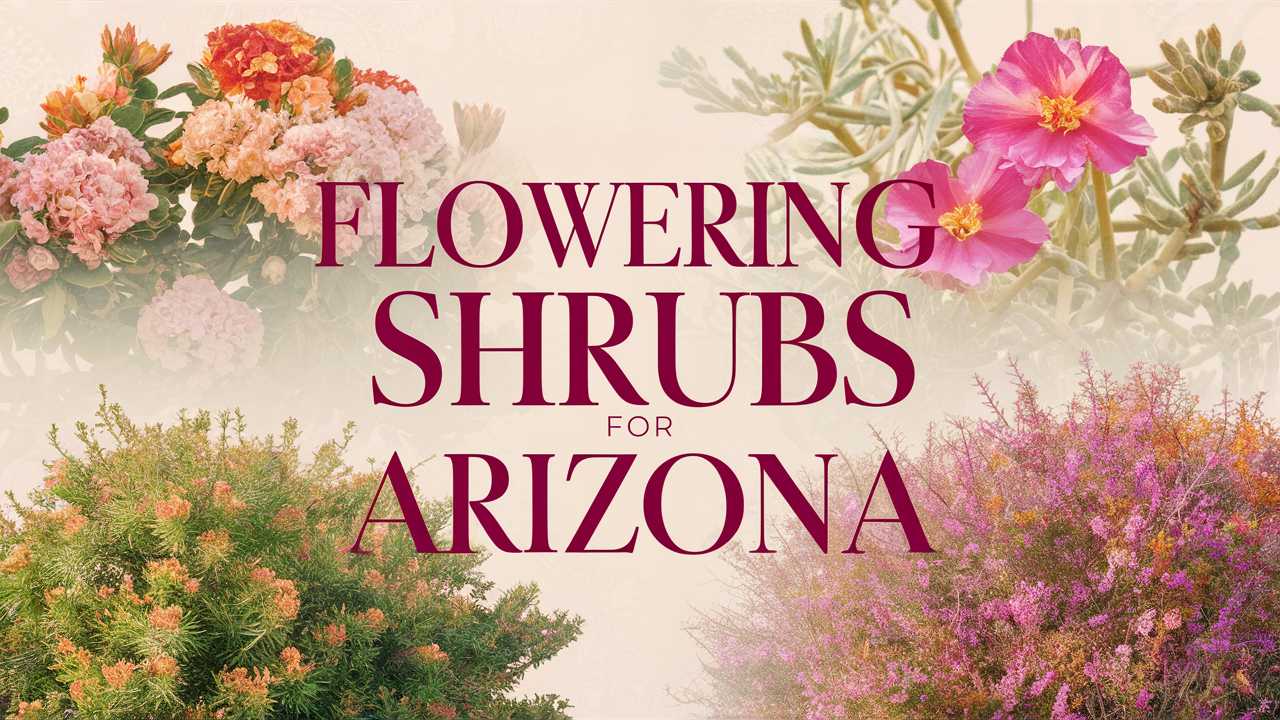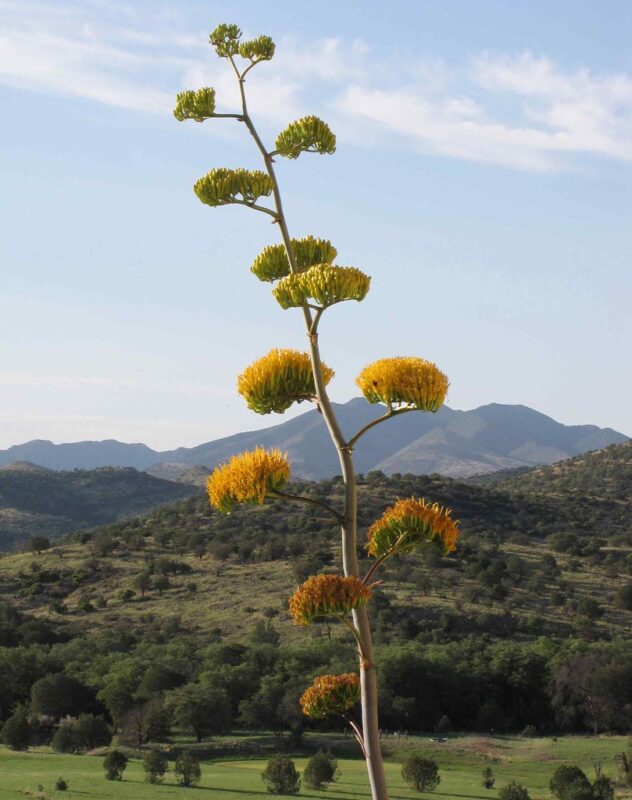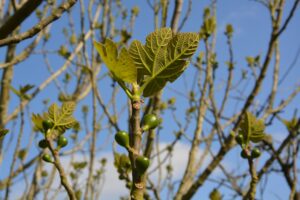This post explores some of the best flowering shrubs for Arizona, showcasing their distinctive characteristics, benefits, and care requirements.
Artemisia tridentata (Big Sagebrush)
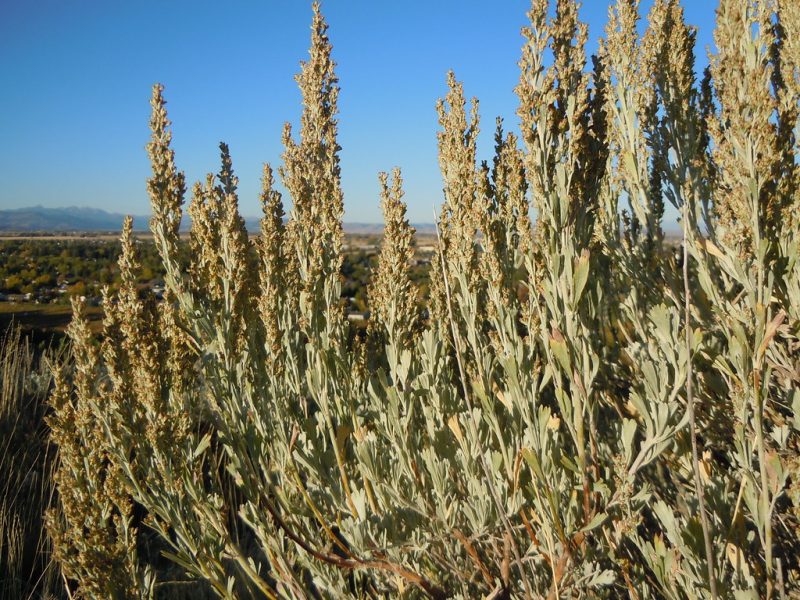
One of the most iconic shrubs in the western United States, Artemisia tridentata, commonly known as Big Sagebrush, thrives in the semi-arid environments of Arizona. This native shrub can grow as high as six feet and features silvery-gray leaves that emit a strong, aromatic scent, especially when brushed against. Big Sagebrush is particularly crucial for local ecosystems as it provides habitat and food for various wildlife.
When planted in gardens, Big Sagebrush not only adds a soft textural contrast but also minimizes water consumption, making it a water-wise choice. Furthermore, its low-maintenance nature includes periodic pruning, and it flourishes in well-drained, sandy soils. Planting Big Sagebrush in clusters can create a stunning visual impact while aiding in soil erosion control.
Salvia dorrii (Desert Sage)

Salvia dorrii, or Desert Sage, is a compact flowering shrub that delights with its stunning purple flowers and aromatic foliage. Blooming from late spring to early summer, the vibrant flowers attract bees, butterflies, and hummingbirds, making it a fantastic addition to any pollinator garden. This shrub typically grows 2-3 feet tall and wide, providing an excellent foundation plant for landscapes or garden borders.
Desert Sage prefers full sun and well-drained soil but is remarkably drought-resistant once established. Regular watering during the first few growing seasons aids in root development. It’s worth noting that Desert Sage often enjoys a slight pruning after blooming to maintain its shape and encourage further growth.
Encelia farinosa (Brittlebush)
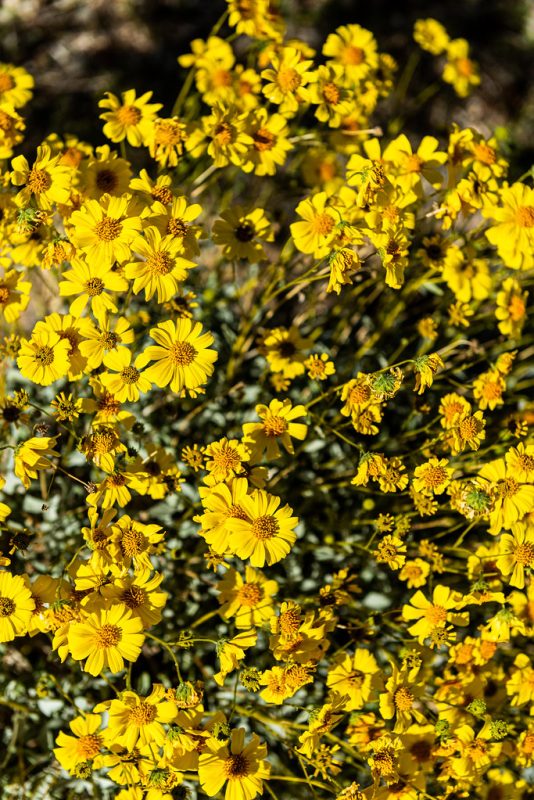
Known for its resilience against the harsh elements of the Arizona desert, Encelia farinosa, or Brittlebush, is a popular choice among gardeners. This evergreen shrub features gray-green foliage and produces bright yellow daisy-like flowers in the spring, creating a cheerful display against the arid landscape.
Brittlebush is an excellent soil stabilizer, often used to combat erosion. The plant thrives best in full sunlight and sandy soils, capable of handling infrequent watering. The leaves contain natural resin, which protects the plant from harsh conditions, and in turn, adds a unique texture to the garden. When planning a xeriscape garden, Brittlebush should be part of the design for its low water needs and stunning bloom.
Fallugia paradoxa (Apache Plume)
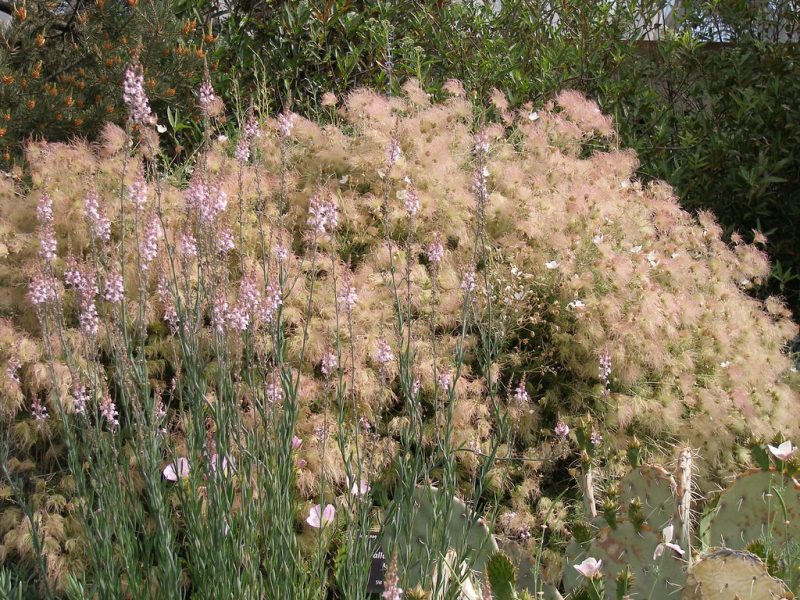
Fallugia paradoxa, or Apache Plume, is a delightful flowering shrub known for its fluffy, feather-like seed heads and delicate white blooms. It is native to the dry regions of Arizona and offers an attractive visual element as it grows between 3-6 feet tall. The flowers that bloom in spring and summer are both beautiful and useful as they attract pollinators seeking nectar.
Apache Plume thrives in poor soils and tolerates drought well, making it an ideal plant for low-maintenance gardens. It appreciates full sun and can be easily shaped through occasional pruning. Additionally, the striking seed plumes that follow the blooms provide interest in fall and winter, ensuring year-round appeal.
Chilopsis linearis (Desert Willow)
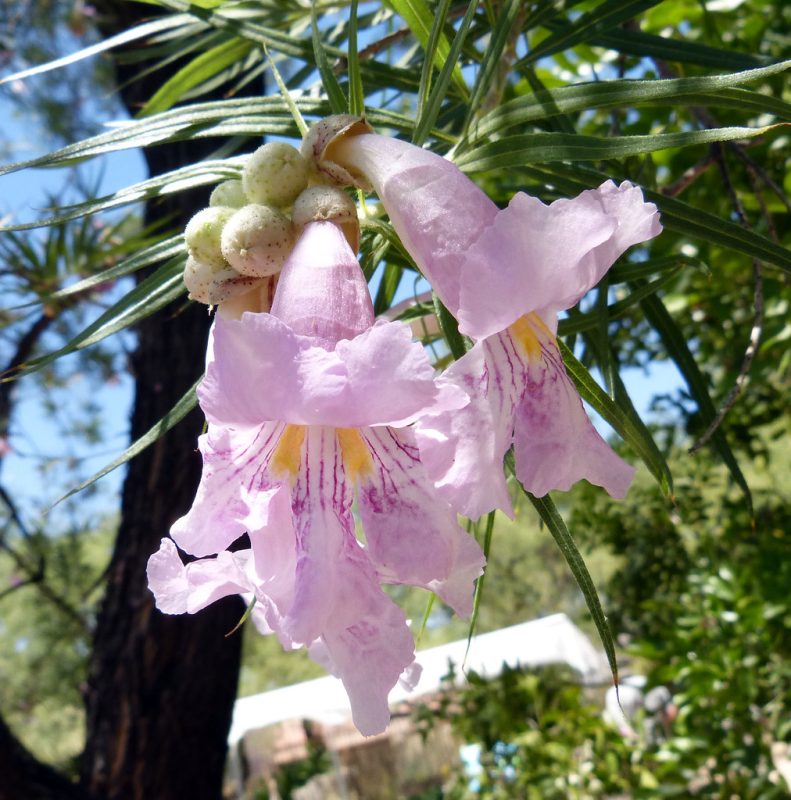
For those who appreciate larger, showy shrubs, Chilopsis linearis, or Desert Willow, is an excellent choice. This tree-like shrub can reach heights of up to 30 feet and blooms with exquisite, trumpet-shaped flowers in shades of lavender, pink, or white during the summer months. The blooms attract hummingbirds and make a stunning focal point in any landscape.
Desert Willow is a drought-tolerant plant that does well in various soil types, particularly if well-drained. Regular watering during its formative years aids growth, but once established, it thrives on neglect. It can be pruned to maintain desired shapes, and its pendulous leaves provide a lovely, soft drape. When planting Desert Willow, consider providing enough space as it can spread wide and tall.
Psorothamnus spinosus (Smoketree)
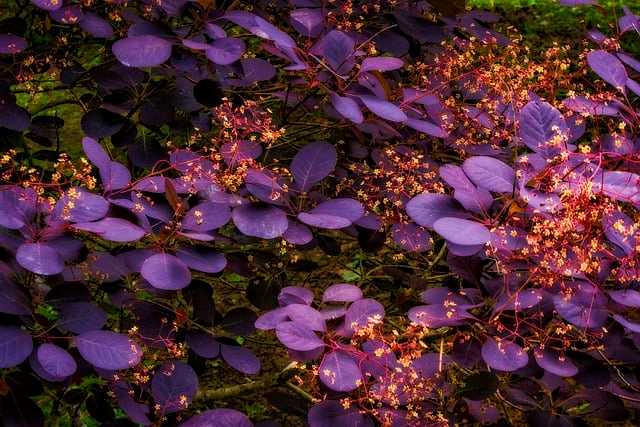
Psorothamnus spinosus, known as Smoketree, is a uniquely beautiful flowering shrub that stands out in the desert landscape. Growing between 3-4 feet tall, it features delicate purple flowers emerging from long spikes, which can give a wispy appearance similar to smoke, hence the name.
This native shrub is highly drought-tolerant and thrives in full sun, making it perfect for low-water gardens. Smoketree blooms in late spring and summer, drawing birds and insects alike. As a bonus, the plant has an intriguing framework of spiny branches that adds interest even when not in bloom. With minimal care requirements, including occasional pruning, Smoketree is an excellent choice for adding character to Arizona gardens.
Condea emoryi (Desert Lavender)
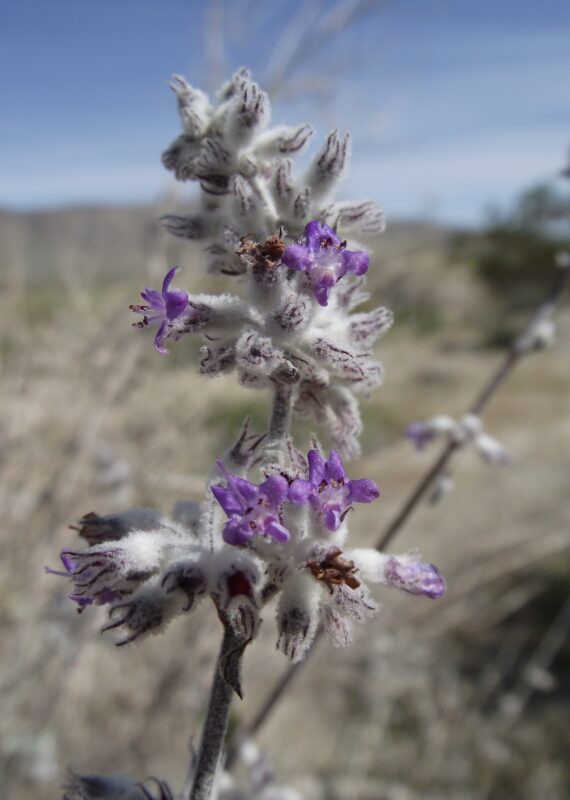
Known for its aromatic foliage and beautiful purple flowers, Condea emoryi, or Desert Lavender, promises both visual and sensory delight. Reaching about 3-4 feet in height, it’s often used in rock gardens or as part of a border due to its compact size. The lavender blooms attract butterflies and bees, enhancing the ecological value of your garden.
Desert Lavender thrives in well-drained soil with minimal watering needs once established. It prefers full sun and can handle drought conditions, making it ideal for the Arizona climate. Regular pruning after flowering encourages bushier growth and prolongs blooming cycles. As a bonus, the fragrant foliage can be harvested for crafting sachets or potpourri.
Justicia californica (Chuparosa)
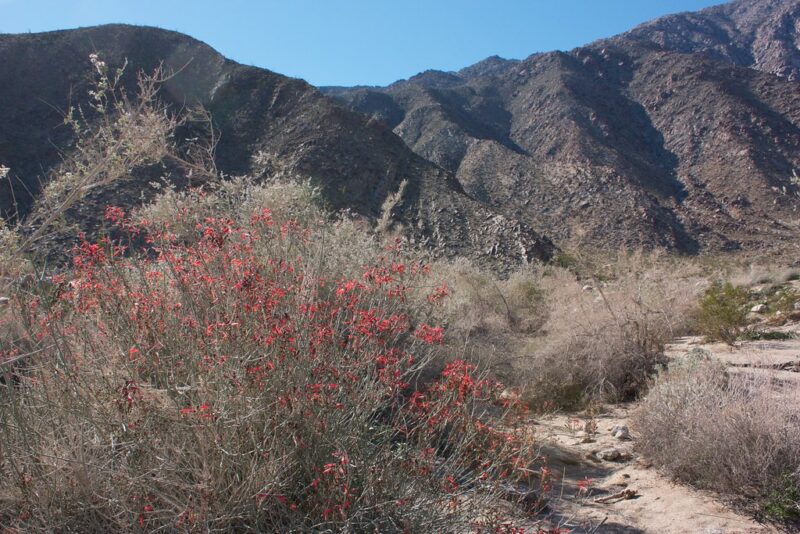
Justicia californica, or Chuparosa, is a profuse bloomer that adds color and life to any Arizona landscape. Sporting tubular red to orange flowers that bloom throughout the warm months, Chuparosa attracts hummingbirds voraciously. This shrub ranges from 3 to 6 feet tall and can thrive in both sun and partial shade, making it a versatile option for various garden styles.
Once established, Chuparosa is quite drought-tolerant, but watering during prolonged dry spells can help it flourish. The dense foliage provides a habitat for wildlife, and it can be pruned to maintain its shape and enhance blooming. When interspersed with other native flora, Chuparosa contributes to a vibrant and sustainability-focused garden.
Larrea tridentata (Creosote Bush)
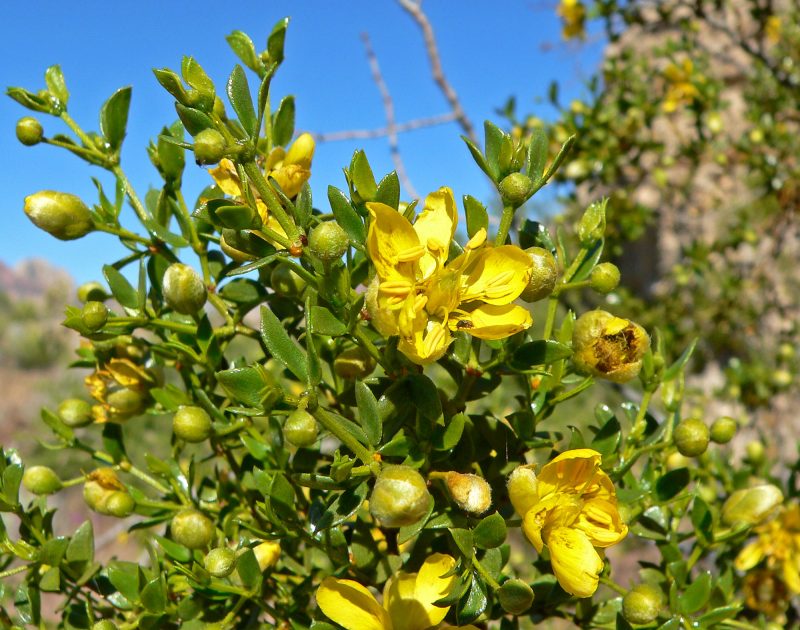
Larrea tridentata, commonly known as Creosote Bush, is perhaps one of the most iconic shrubs in Arizona’s deserts. This hardy shrub is characterized by its glossy green leaves and distinct yellow flowers that bloom primarily in the spring. The unique scent emitted after rainfall—often described as a fresh, earthy aroma—is a hallmark of the desert, thanks to Creosote Bush.
This resilient shrub can tolerate extreme heat and drought conditions, making it a low-maintenance option for arid gardens. With its sprawling nature, Creosote Bush can be used for ground cover or to define the edges of garden beds. It’s a vital part of the ecosystem, providing food and shelter for various birds and insects. A well-placed Creosote Bush can serve as a living testament to the beauty and resilience of desert flora.
Fouquieria splendens (Ocotillo)
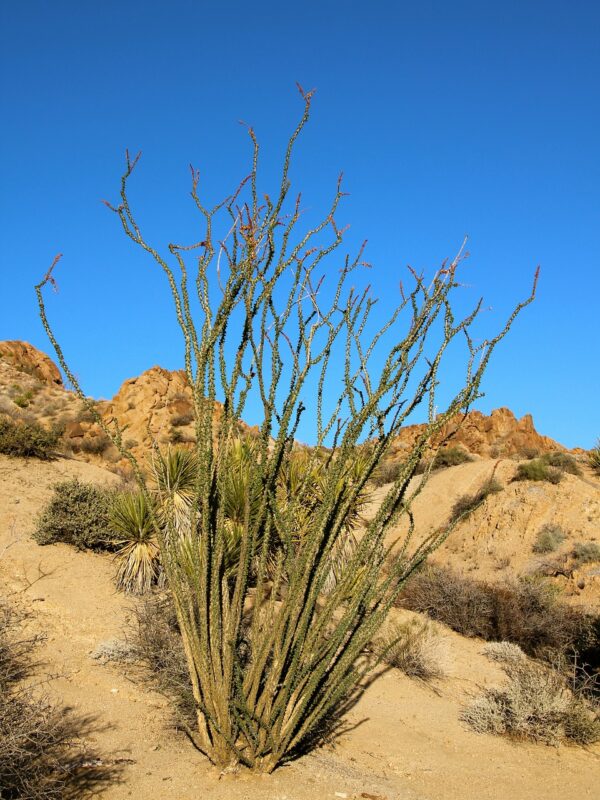
A striking addition to any garden, Fouquieria splendens, or Ocotillo, is more accurately described as a shrub or small tree. Reaching heights of 10-20 feet, this plant is known for its long, slender canes and vibrant red tubular flowers that bloom in spring and summer. The visual appeal of the Ocotillo, especially when in bloom, is unparalleled, making it a focal point in desert landscaping.
Ocotillo thrives in extremely dry environments and requires little to no water once established. It prefers well-drained soil and full sun exposure. As it goes dormant in the winter, Ocotillo adds seasonal interest to the garden with its naked, branch-like structure. Adding Ocotillo to your landscape is not just an aesthetic choice; it also supports local wildlife, offering nectar for pollinators during its flowering period.
Cleome isomeris (Bladderpod)
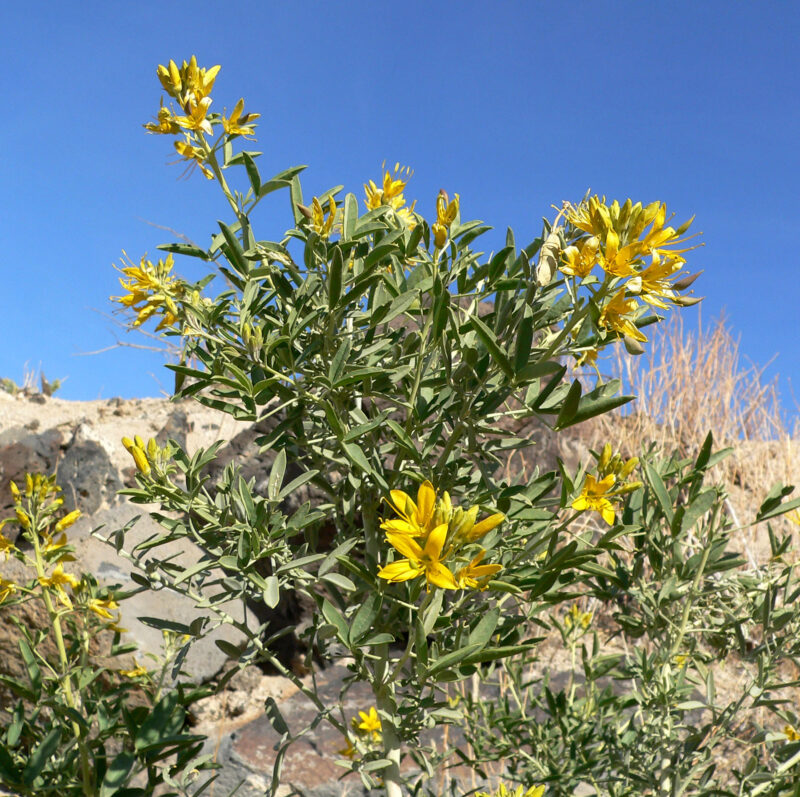
Distinct in its appearance and flowering habits, Cleome isomeris, or Bladderpod, offers unique yellow blooms that resemble fluffball clusters. This drought-tolerant shrub grows to about 3 feet and has leathery, upright stems that provide an interesting backdrop for other flowering plants in your landscape.
Bladderpod enjoys full sun and thrives in poor soils, which makes it an excellent candidate for low-water gardens. Its flowers bloom mainly in spring, providing a splash of color while also attracting beneficial pollinators. Regular pruning after flowering can encourage new growth and maintain bushiness. Planting Bladderpod along driveways or pathways can create an attractive, carefree landscape.
Baccharis sarothroides (Desert Broom)
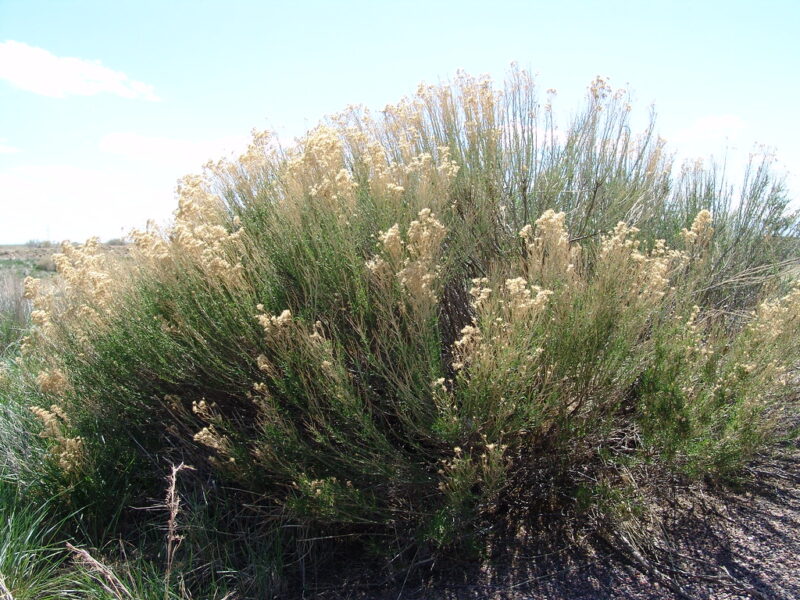
Baccharis sarothroides, or Desert Broom, is a fast-growing shrub that can reach heights up to 10 feet. Its slender, broom-like stems create an elegant vertical element in the garden, and during the fall, it becomes adorned with fluffy white flower heads. This shrub is particularly beneficial for erosion control, as its extensive root system helps stabilize the soil.
Desert Broom thrives in dry conditions and tolerates full sun well. Though it does best with minimal watering, a little extra during long dry seasons will enhance its growth. Additionally, it’s low-maintenance, requiring little more than occasional pruning to manage its structure. The soft, bushy appearance of Desert Broom makes it a great filler plant in larger landscapes.
Cordia boissieri (Texas Olive)
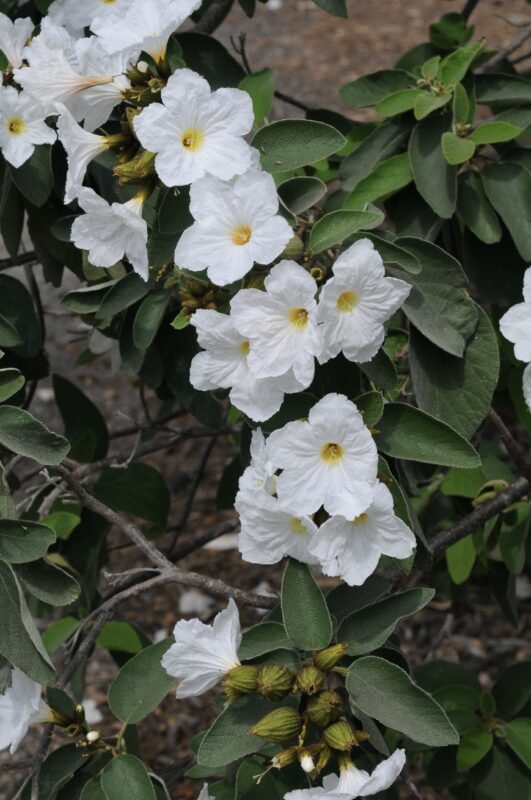
Cordia boissieri, or Texas Olive, brings a unique charm to Arizona landscapes with its glossy leaves and white flowers that bloom year-round, particularly during warmer months. Growing to about 15 feet tall, this shrub or small tree makes an excellent choice for providing shade and visual interest.
With moderate water needs, Texas Olive thrives in well-drained soils and full sun conditions. Its ability to adapt to varying soil types makes it versatile for different landscapes. Additionally, the blooms attract various pollinators, making it an environmental asset as well. Regular pruning helps maintain its shape and encourages bushier growth, enhancing its overall presence in the garden.
Purshia tridentata (Antelope Bitterbrush)
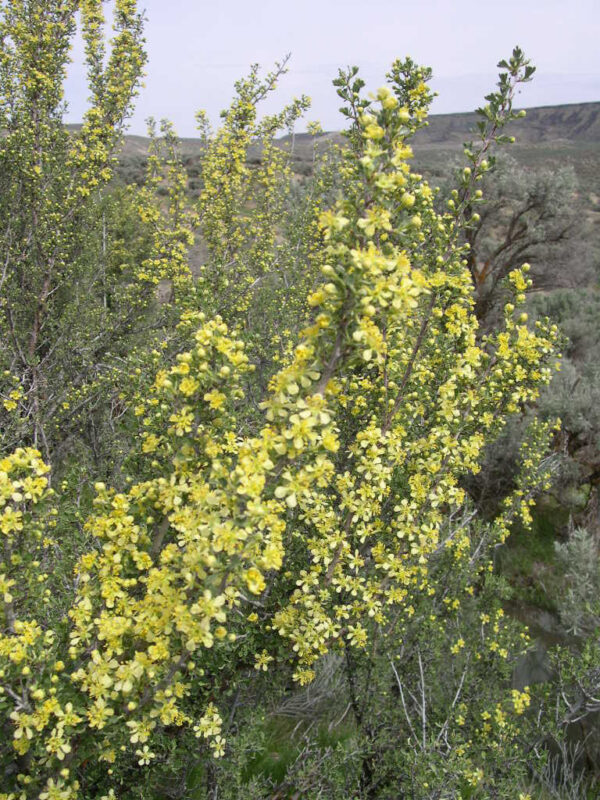
A vital component of many desert ecosystems, Purshia tridentata, or Antelope Bitterbrush, showcases striking yellow blooms. This deciduous shrub typically grows between 3-6 feet tall and serves as crucial habitat and food for native wildlife, including deer and various insect species.
Antelope Bitterbrush is highly drought-resistant and thrives in poor, well-draining soils, making it an ideal selection for xeriscape gardens. Once established, it requires minimal maintenance and can endure harsh sun exposure. Regularly pruning this shrub can enhance blooming and create a well-kept appearance while contributing to effective soil stabilization within your garden.
Senegalia greggii (Catclaw Acacia)
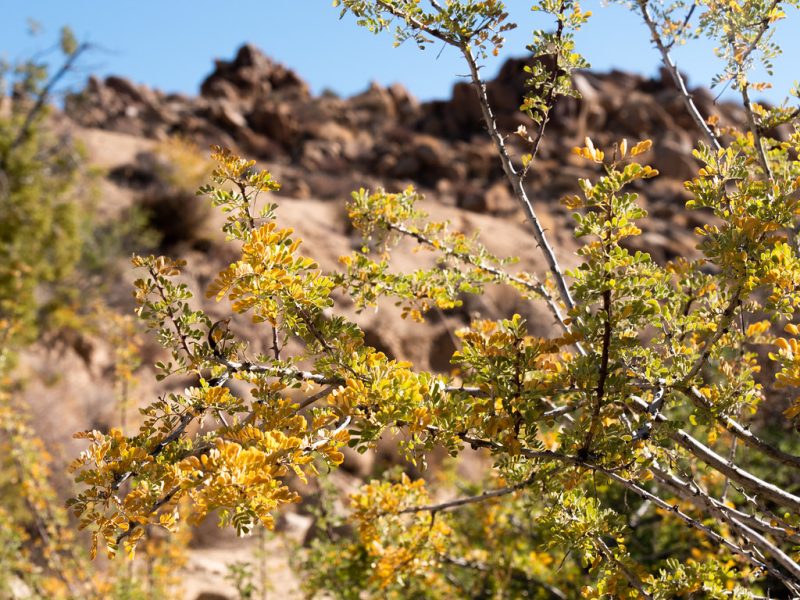
Senegalia greggii, or Catclaw Acacia, is celebrated for its graceful, feathery foliage and vibrant yellow, pom-pom blooms. Reaching heights of 6-12 feet, this shrub provides excellent cover for birds and other wildlife. Its thorny structure offers additional protection for smaller creatures seeking refuge.
This shrub thrives in well-drained soils and requires full sun to flourish. Catclaw Acacia is drought-tolerant once established but appreciates occasional watering during extremely dry spells. Its low maintenance requirements and ability to thrive in poor soil conditions make it a popular choice for landscaping in Arizona. Regular pruning can help maintain shape and productivity, resulting in a visually appealing landscape.
Prosopis velutina (Velvet Mesquite)
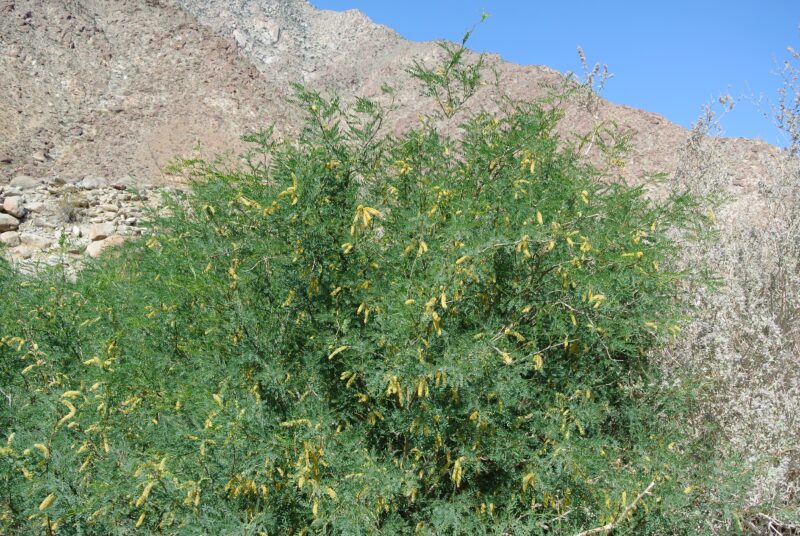
Prosopis velutina, or Velvet Mesquite, plays a significant ecological role in Arizona landscapes. This medium to large shrub can reach heights of 15-30 feet, adorned with fragrant yellow flowers that bloom in the summer. The pods provide a food source for wildlife, and the shady canopy is perfect for many plants and animals needing shelter from the harsh sun.
Velvet Mesquite is well-adapted to the desert and thrives on minimal water once established, making it highly drought-tolerant. Its deep root system allows it to access water that other plants may not reach, contributing to its resilience. Additionally, regular pruning can enhance its shape and productivity, making it a desirable option for home landscapes.
Prosopis pubescens (Screwbean Mesquite)
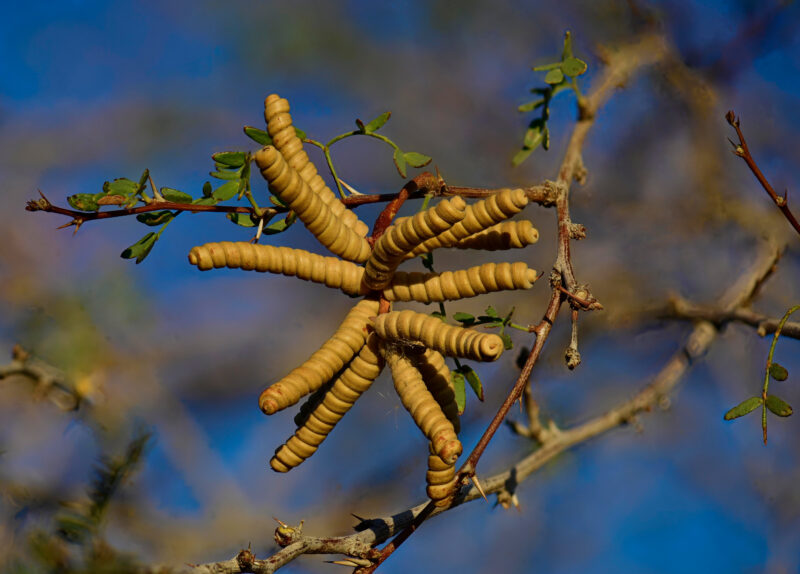
Prosopis pubescens, or Screwbean Mesquite, is renowned for its twisted seed pods that resemble screws, adding a unique feature to your garden once the flowers bloom in late spring through summer. Growing to about 15-25 feet tall, this shrub/tree offers excellent shade and arthropod diversity.
Screwbean Mesquite thrives in arid conditions and can handle different soil types, preferring moist or well-drained soils. Like its counterparts, this shrub is drought-tolerant once established and attracts many pollinators with its fragrant blooms. Regular watering during establishment and pruning will help maintain shape and health in your landscape.
Tecoma stans (Yellow Bells)
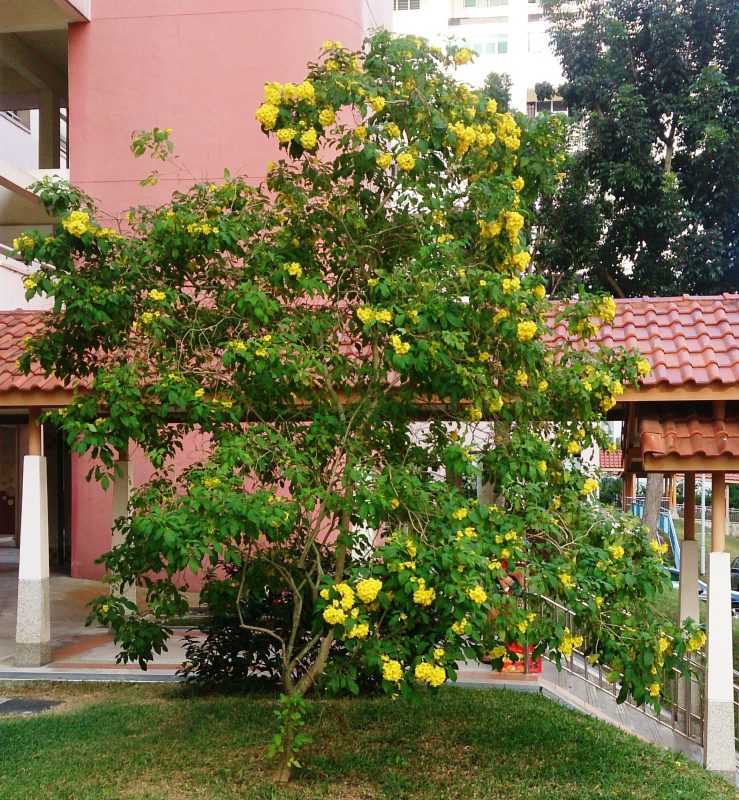
Tecoma stans, or Yellow Bells, is a vibrant shrub that produces clusters of bright yellow trumpet-shaped flowers, attracting butterflies and hummingbirds alike. Reaching heights of 6-10 feet, this deciduous shrub brings a cheerful touch to any garden.
Yellow Bells thrive in well-drained soil and are highly tolerant of the sun and heat, making them excellent for xeriscaping. Regular watering encourages more prolific blooms, especially during hot summers. Minimal pruning is needed aside from shaping, but cutting back after flowering can promote denser growth. Incorporating Yellow Bells into your garden not only enhances aesthetic appeal but supports local ecosystems.
Calliandra californica (Baja Fairy Duster)
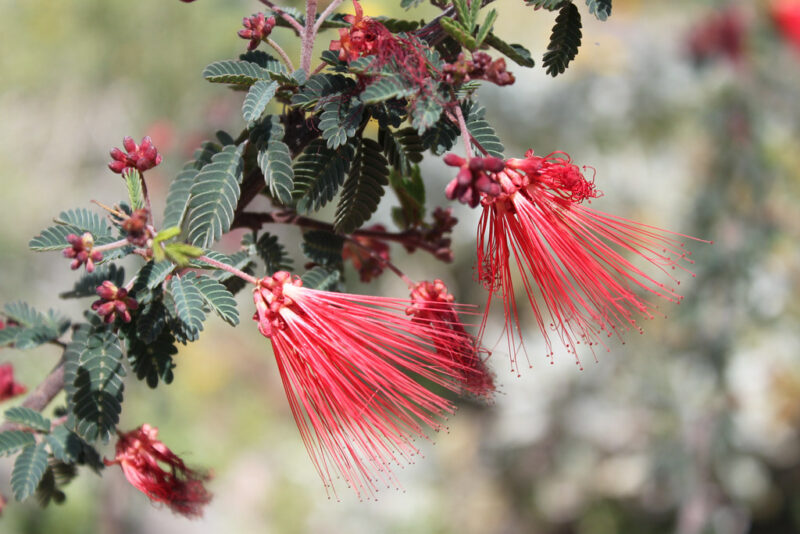
Known for its whimsical, pink pom-pom flowers, Calliandra californica, or Baja Fairy Duster, mesmerizes anyone who encounters it. This compact shrub typically grows to about 3-5 feet, making it perfect for smaller gardens or as a border plant.
Baja Fairy Duster thrives in dry, rocky soils and requires full sunlight to flourish. This low-water plant is particularly appealing due to its resilience against drought. Regular pruning encourages bushier growth and maximizes blooming potential. The nectar-rich flowers are not only beautiful but also serve as an important food source for hummingbirds and beneficial insects.
Prosopis glandulosa (Honey Mesquite)
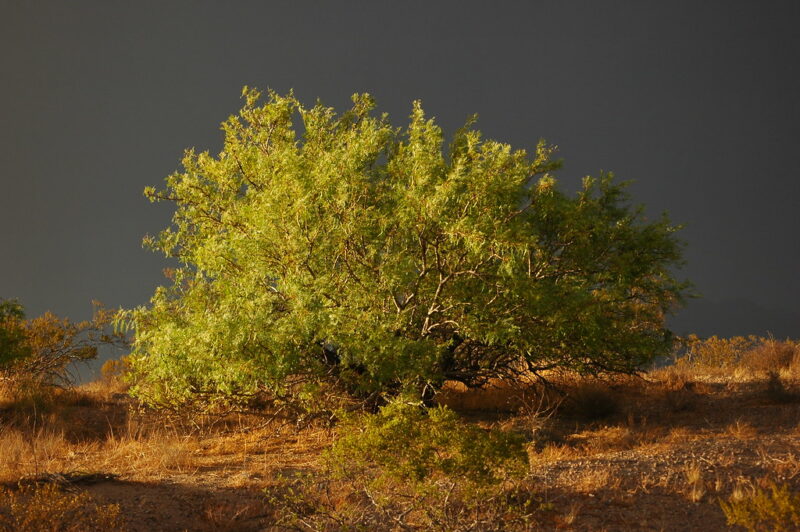
Another notable variety, Prosopis glandulosa, or Honey Mesquite, is notable for its fluffy yellow flowers and flavorful pods. This robust shrub can reach heights between 15-30 feet, providing shade and habitat for local wildlife.
Honey Mesquite is drought-tolerant and adaptable to various soil types, thriving under arid conditions. It typically requires minimal care, though watering during prolonged droughts may support healthier growth and flowering. Regular pruning helps maintain its size and improves overall structure, leading to a more polished appearance in your landscape.
Eriogonum fasciculatum (California Buckwheat)
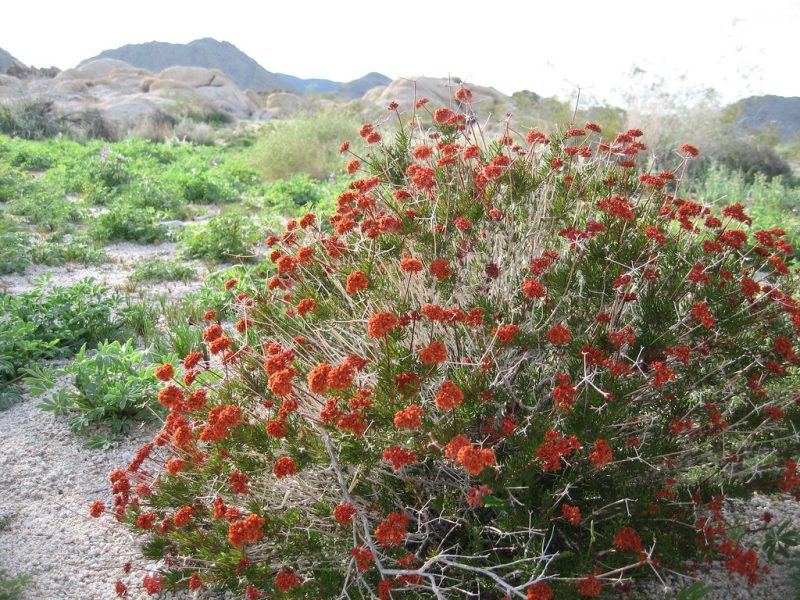
Eriogonum fasciculatum, or California Buckwheat, is a low-growing shrub that blooms with clusters of small, creamy to pinkish flowers. This hardy plant typically grows between 2-3 feet tall and produces flowers in the spring and summer months, attracting bees and butterflies.
Buckwheat thrives in dry, sandy soils and full sun, making it an ideal choice for low-water gardens. It can withstand drought once established and contributes to soil stability. Minimal maintenance is required, with occasional pruning necessary to maintain desired form and health. California Buckwheat serves as an essential source of nectar in the ecosystem, making it a valuable addition to any garden.
Atriplex canescens (Four-Wing Saltbush)
Atriplex canescens, or Four-Wing Saltbush, is a unique shrub characterized by its gray-green foliage and distinctive, winged seeds. This drought-tolerant plant typically grows 4-6 feet tall and is particularly useful for erosion control and soil stabilization.
Saltbush thrives in alkaline soils and tolerates saline conditions, making it a perfect choice for challenging planting areas. With little water required once established, it’s a sustainable option for arid environments. Regular pruning helps several plants maintain inward growth, enhancing their longevity and overall appeal in landscaping projects.
Dodonaea viscosa (Florida Hopbush)
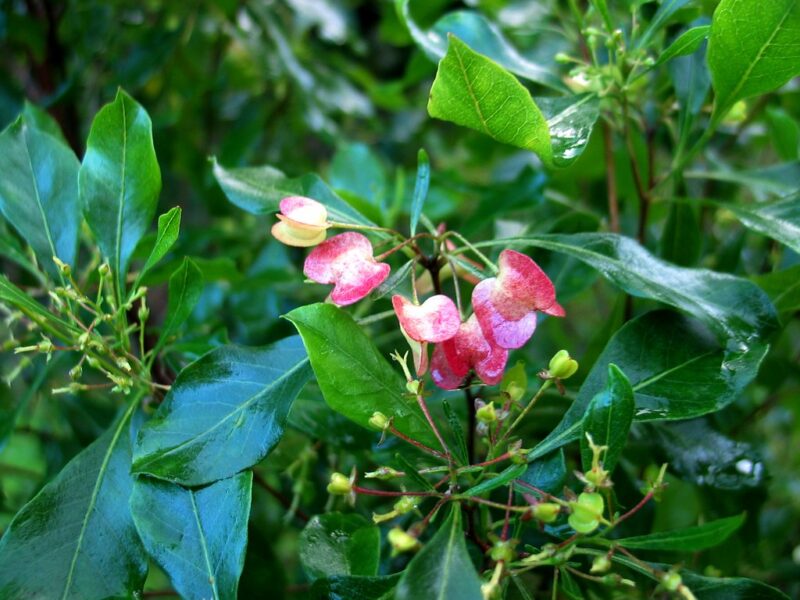
Dodonaea viscosa, commonly referred to as Florida Hopbush, is a shrub that can grow up to 10 feet tall, making it an excellent choice for barriers and hedges. It features glossy leaves and clusters of inconspicuous flowers that give way to colorful winged seed pods.
This shrub is tolerant of drought and thrives in a variety of soils, provided they are well-drained. Florida Hopbush is low-maintenance and requires minimal pruning, making it perfect for busy gardeners. Its ability to withstand wind and salt makes it a great choice for coastal or elevated areas, enhancing the resilience of Arizona gardens against harsh elements.
Agave americana (Century Plant)
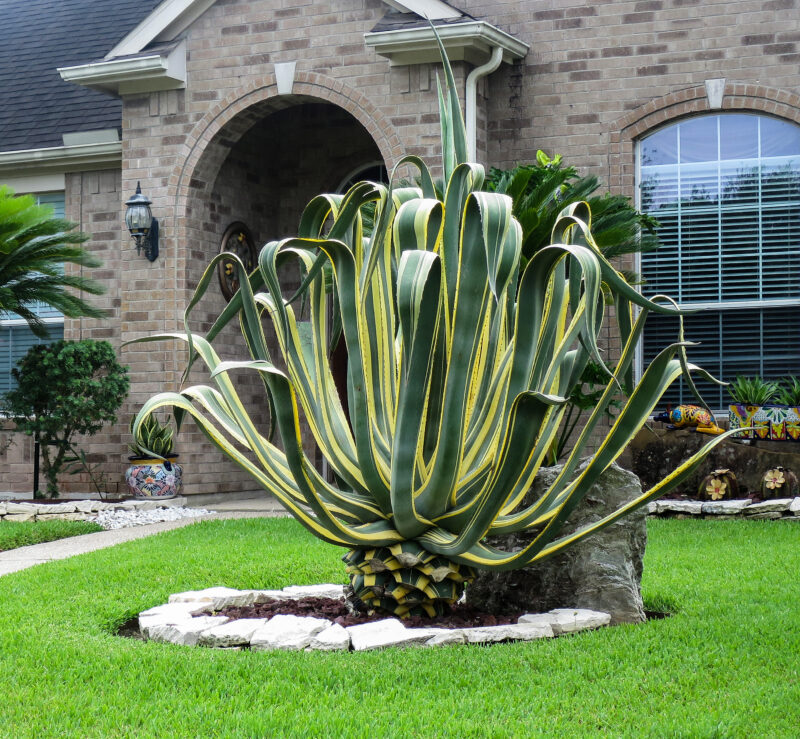
Agave americana, or Century Plant, is a stunning architectural element in any desert garden. This dramatic succulent can reach heights and widths of up to 6 feet, producing an imposing rosette of thick, fleshy leaves that are bluish-green with sharp margins.
Although it doesn’t produce flowers every year, when it does bloom, it sends up a tall stalk with yellow flowers, captivating any observer. Century Plant requires minimal water and thrives in full sun, making it a perfect candidate for xeriscaping. With its low-maintenance nature and impressive appearance, it adds instant drama to any landscape.
Caesalpinia pulcherrima (Red Bird of Paradise)
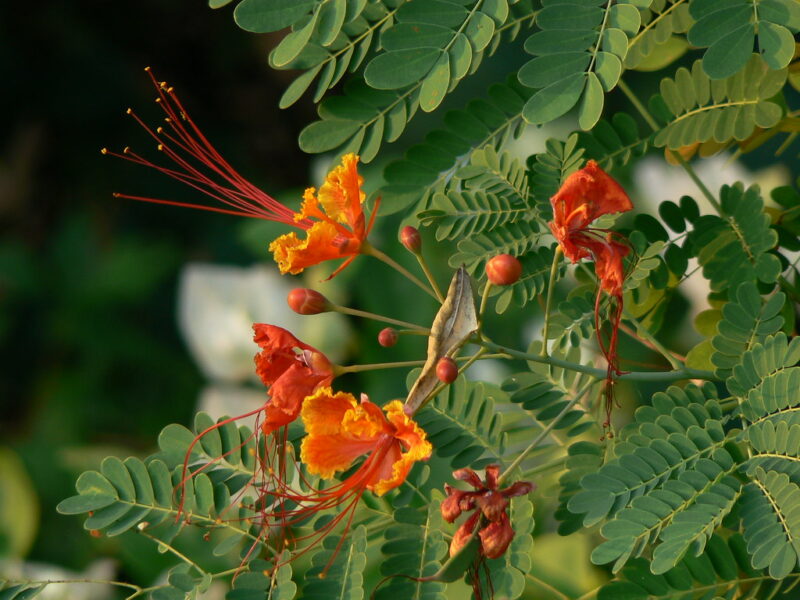
Known for its exotic appearance, Caesalpinia pulcherrima, or Red Bird of Paradise, can reach heights of 2-8 feet and produces stunning orange and yellow flowers throughout the summer. This shrub is perfect as a specimen plant or as part of vibrant mixed borders.
The Red Bird of Paradise enjoys well-drained soils and full sun, with moderate water once established. Pruning enhances its natural shape and encourages a second bloom, providing continued color throughout the growing season. As a magnet for pollinators, this vibrant shrub enhances the ecological diversity of your landscape.
Agave chrysantha (Golden Flowered Century Plant)
Closely related to its cousin, Agave chrysantha, or Golden Flowered Century Plant, is known for its stunning yellow flowers, which create a beautiful contrast against its italic green leaves. This architectural plant can reach substantial sizes, typically around 3-4 feet high, and typically blooms after several years of growth.
Golden Flowered Century Plant thrives in well-drained, dry soils and requires minimal maintenance once established. It represents a stunning, drought-tolerant option suitable for arid gardens. Its dramatic blooms attract hummingbirds, providing a vibrant addition to the plant community. This plant can also serve as an excellent focal point in any desert-inspired landscape.
Leucophyllum frutescens (Texas Sage)
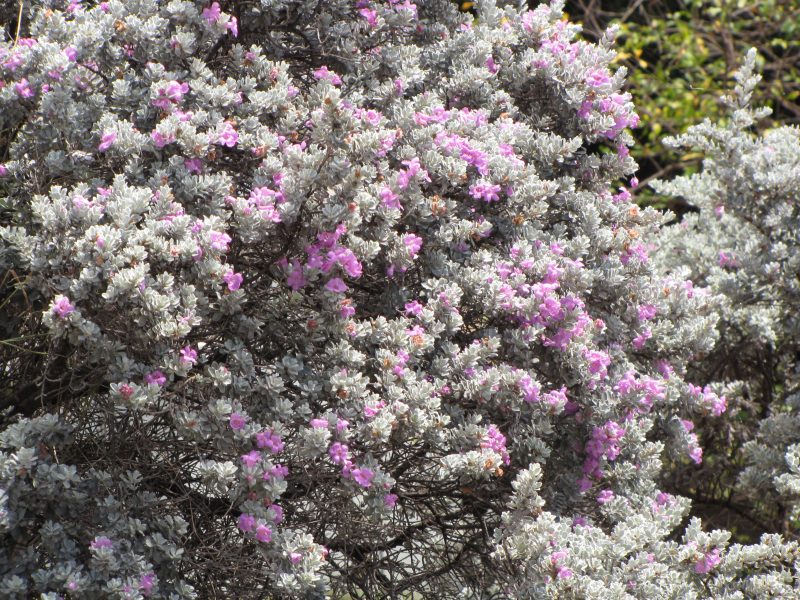
Leucophyllum frutescens, commonly known as Texas Sage or Barometer Bush, is revered for its stunning silvery foliage and bright purple blooms. Growing between 3-5 feet tall, this shrub is iconic in desert landscaping, known for blooming profusely after rain.
Texas Sage thrives in well-drained soil and full sun, requiring minimal irrigation once established. It’s an excellent choice for low-maintenance gardens due to its resiliency to drought conditions and adaptable nature. Regular shaping after flowering can improve bushiness and stimulate new growth, making it a popular choice for hedges or feature plants.
Mahonia trifoliolata (Agarita)
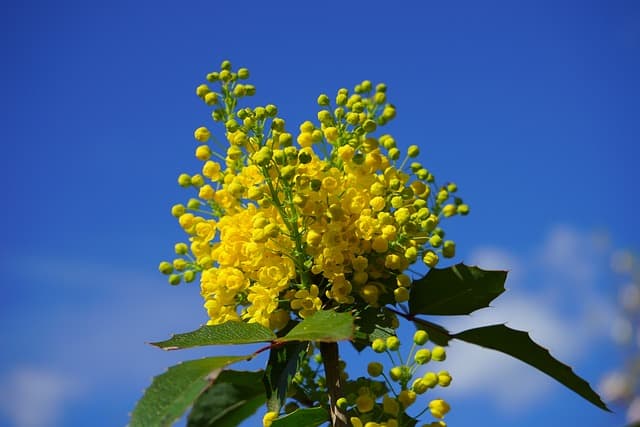
Mahonia trifoliolata, also known as Agarita, is a spiny shrub offering eye-catching yellow blooms in spring. Ranging in height from 3-6 feet, it also features glossy, holly-like leaves, creating a textural contrast in gardens. Throughout the growing season, Agarita attracts many pollinators, enhancing biodiversity.
This shrub thrives in arid conditions and tolerates poor soil, contributing to its status as a fantastic low-maintenance plant. It requires little water once established, and regular pruning helps maintain shape and encourages fuller foliage. For those looking to add both beauty and habitat to their landscape, Agarita is an excellent choice.
Baccharis salicifolia (Mule Fat)
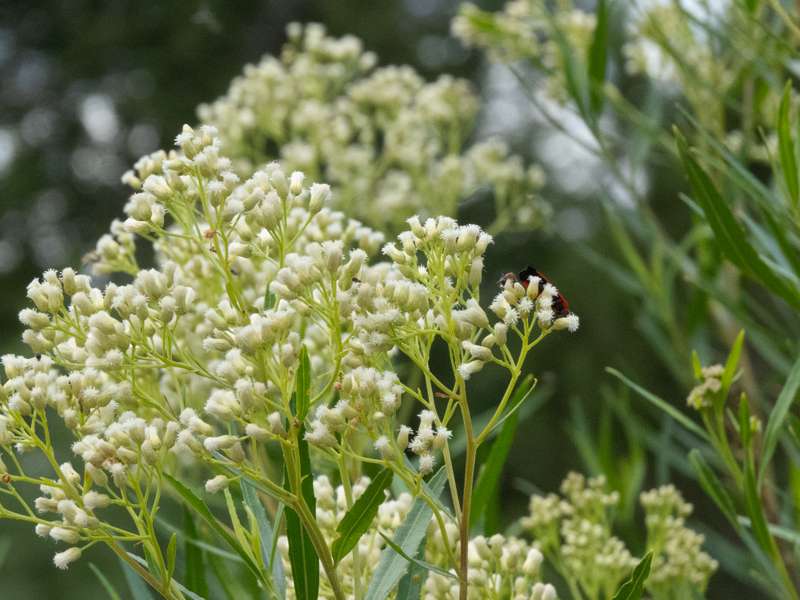
Baccharis salicifolia, or Mule Fat, is a soft-stemmed shrub well-suited for wet or riparian environments. Growing between 3-10 feet tall, it’s known for its tall, spreading nature and clusters of creamy-white flowers. Mule Fat serves as a critical habitat for various wildlife, often found in nature alongside rivers and streams.
This shrub thrives in full sun and tolerates wet soil but is highly adaptable to various growing conditions. Minimal watering is necessary once established, making Mule Fat a great option for water-wise gardens. Regular pruning encourages denser foliage and healthier blooms. When incorporated into a landscape, Mule Fat not only beautifies the environment but also contributes to the ecological richness.
Dasylirion wheeleri (Desert Spoon)
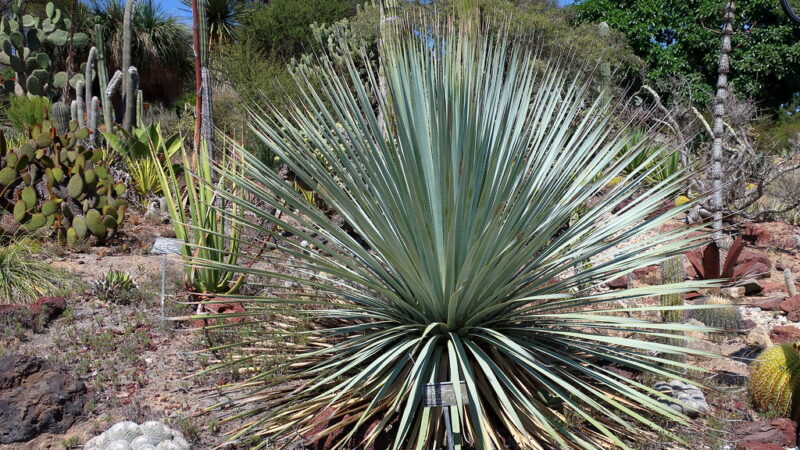
A unique addition to any xeriscape garden, Dasylirion wheeleri, or Desert Spoon, possesses stunning spiral foliage that adds a touch of elegance. Growing up to 4 feet tall, the dense, sword-like leaves create a striking architectural feature. The tall flower spikes that emerge in spring add additional height and visual interest with their creamy white blossoms.
Desert Spoon prefers well-drained soils and showcases remarkable drought resilience, thriving in full sunlight. Minimal maintenance is required, aside from occasional pruning to manage dead leaves. Its architectural form and drought-tolerance make it an unparalleled choice for desert gardens while serving as a conversation starter among visitors.
Rhus ovata (Sugar Sumac)
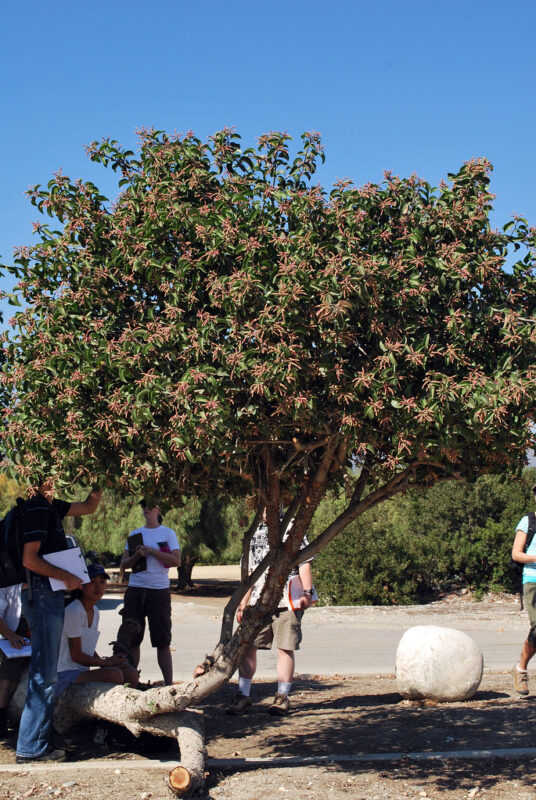
Rhus ovata, also known as Sugar Sumac, is native to the southwestern United States and is known for its attractive mound shape and dense, dark green foliage. This shrub grows between 4-8 feet tall, showcasing small yellow-green flowers in spring that are highly favored by pollinators, followed by red-hued berries in the fall.
Sugar Sumac grows best in sunny locations and well-draining soil, requiring little water once established. Its drought-tolerant nature makes it ideal for xeriscaping gardens. The unique mound shape can provide excellent cover for wildlife, while regular pruning encourages a fuller, denser appearance, leading to a more ornamental garden presence.
Ericameria nauseosa (Rubber Rabbitbrush)
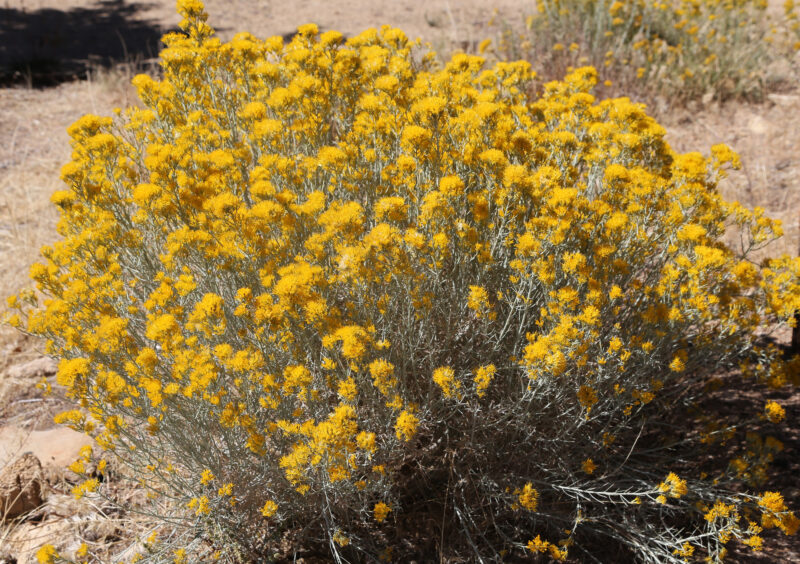
Ericameria nauseosa, or Rubber Rabbitbrush, is a resilient shrub that blooms vibrant yellow flowers in the fall, creating a striking display. Growing to heights of 3-6 feet, its aromatic foliage adds a burst of color to desert landscapes.
Rubber Rabbitbrush tolerates poor soils and requires low water once established, making it a great choice for arid gardens. This shrub thrives in full sun and can withstand drought conditions while attracting various pollinators. Regular pruning after bloom encourages bushier growth and enhances its overall appearance.
Acacia farnesiana (Sweet Acacia)
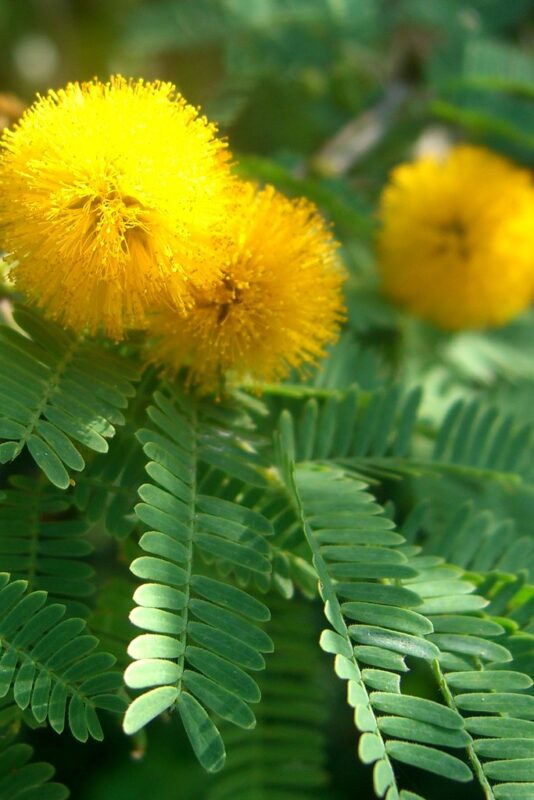
Acacia farnesiana, known as Sweet Acacia, stands out with its striking yellow flower clusters and rounded growth habit. This lovely shrub can reach heights of 10-15 feet, providing a vibrant contrast against Arizona’s natural backdrop.
Sweet Acacia is quite drought-tolerant, thriving in nearly any soil type with good drainage. It requires minimal care, making it a popular choice for busy gardeners. The fragrant flowers attract bees and other pollinators, enhancing the biodiversity of your garden. Pruning is recommended after flowering to promote fuller growth and prolonged blooming cycles.
Rivina humilis (Bloodberry)
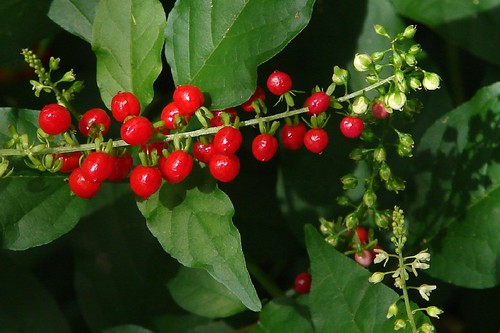
A unique choice for garden enthusiasts, Rivina humilis, or Bloodberry, is a small shrub known for its bright red berries that adorn the plant throughout the late summer and fall. Typically growing to about 3 feet tall, Bloodberry features green, oval leaves and small, pink flowers that provide a delicate contrast to its shiny berries.
This shrub thrives in well-drained soil and full to partial shade, making it versatile for various garden designs. Watering requirements are low once established, ensuring minimal maintenance. Bloodberry is valuable for attracting birds and wildlife, making it an ecological asset alongside a vibrant and colorful plant choice. Regular pruning encourages bushier growth and healthier blooms.
Cercocarpus betuloides (Mountain Mahogany)
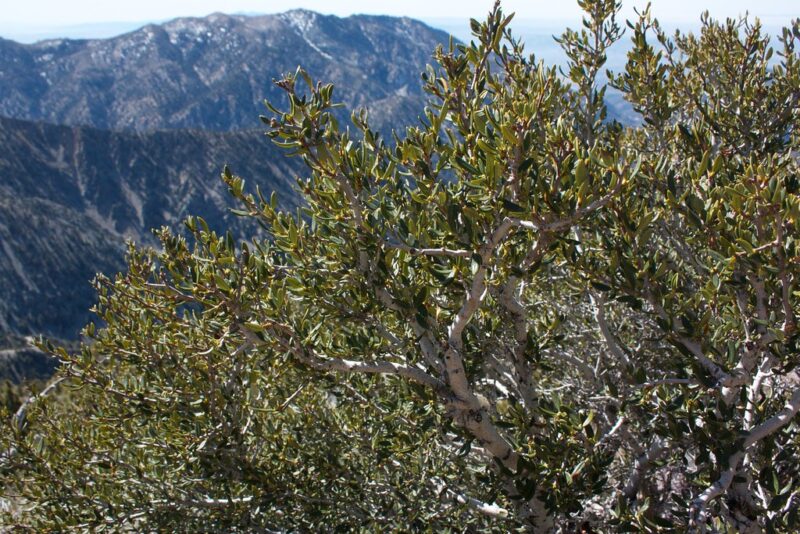
Cercocarpus betuloides, or Mountain Mahogany, is characterized by its attractive gray-green leaves and unique, fluffy seed heads in late summer. This dense shrub can grow between 10-20 feet tall, making it an excellent plant for providing cover and shelter in gardens.
Mountain Mahogany thrives in well-drained soils and full sunlight and requires minimal care once established. Its drought-resistant nature makes it suitable for low-water landscaping, while its dense growth can offer a striking visual element in garden designs. Regular pruning can promote a fuller appearance and enhance its overall health.
Rhamnus californica (California Coffeeberry)
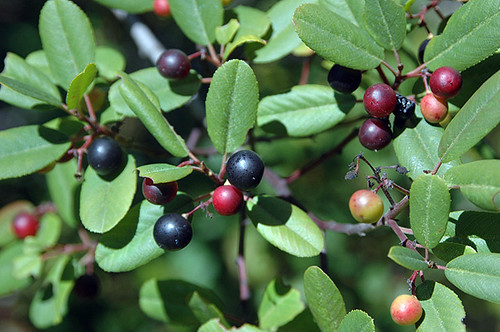
Rhamnus californica, or California Coffeeberry, is a great back-to-nature shrub that adds a sense of elegance with its dark green foliage and unique berry-like drupes. Ranging from 3 to 8 feet tall, this shrub provides an excellent backdrop or privacy screen in landscapes.
California Coffeeberry is well-suited for various soil types and thrives in both full sun and partial shade. It is drought-tolerant once established, making it an excellent choice for water-efficient gardening. Additionally, its berries attract birds, enhancing the ecological value of your garden. Minimal pruning keeps this shrub looking neat, ensuring it remains a beautiful feature in any Arizona landscape.
Fremontodendron californicum (California Flannelbush)

Fremontodendron californicum, known as California Flannelbush, offers beautiful yellow tissue-paper-like flowers that bloom in the early spring. This shrub can grow between 6-15 feet tall, making it a stunning focal point in any landscape.
Flannelbush thrives in excellent drainage conditions and full sun, requiring little water. Despite its subtle maintenance needs, it dramatically impacts garden aesthetics with its vibrant blooms and soft foliage. Its natural resilience against drought makes it perfect for xeriscaping while also attracting pollinators during its blooming cycle. Regular pruning helps maintain its structure and encourages a dense, healthy presentation.
Punica granatum (Pomegranate)
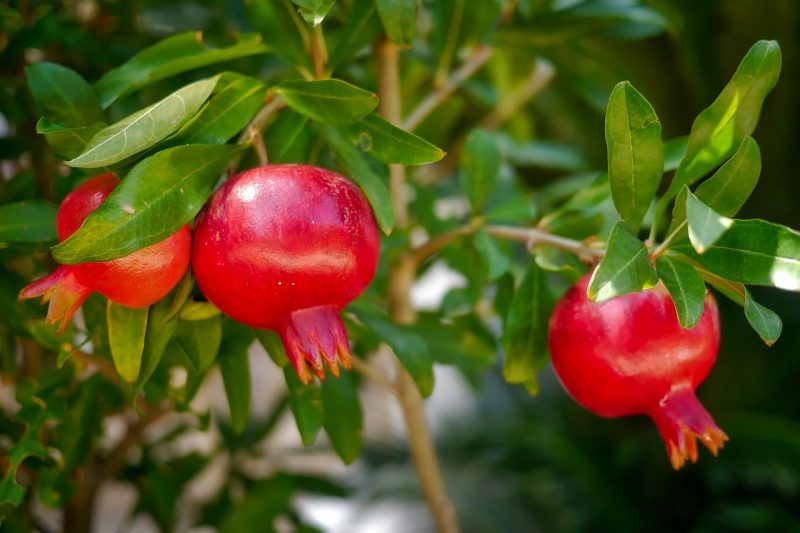
Famous for its delectable fruit, Punica granatum, or Pomegranate, is not only a beautiful shrub but also a productive one. Growing between 5-12 feet, its stunning red blooms appear in late spring to summer, followed by the fruit that many crave.
Pomegranate thrives in well-drained soil and full sun, requiring regular watering during its formative years but quickly adapting to dry soils once established. This shrub adds not only beauty to landscapes but also seasonal interest, with colorful blooms and fruit that attracts birds and other wildlife. Minimal pruning is needed to retain its shrub form, making it a beloved choice in many Arizona gardens.
Amelanchier utahensis (Utah Serviceberry)

Amelanchier utahensis, or Utah Serviceberry, is an ornamental shrub known for its stunning spring flowers and vibrant fall foliage. This shrub typically grows between 6-15 feet tall, producing clusters of white flowers that attract bees, followed by edible berries that are a favorite of birds.
Utah Serviceberry prefers well-drained soils and full sun to partial shade. Once established, it requires minimal care, making it a robust addition to gardens. The multiseasonal appeal—blossoms in spring, berries in summer, and colorful foliage in the fall—ensures that it remains an eye-catching feature throughout the year. Regular pruning encourages growth and maintains its beautiful form within the landscape.
Rhamnus ilicifolia (Hollyleaf Redberry)
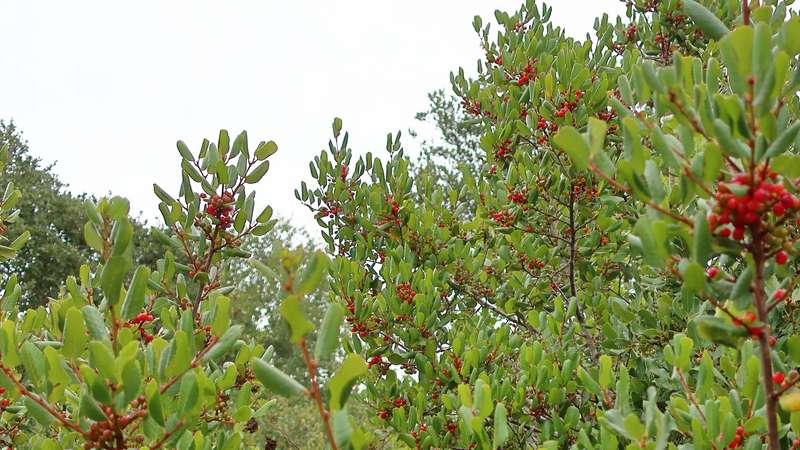
The Rhamnus ilicifolia, or Hollyleaf Redberry, is a versatile shrub characterized by its evergreen leaves and small, red berries in the fall. This plant ranges from 4-10 feet tall and offers excellent cover for native birds and wildlife.
Hollyleaf Redberry thrives in well-drained soils and can adapt to full sun or partial shade. It is drought-tolerant once established but appreciates occasional watering during extreme droughts. The dense foliage creates a lush appearance, and regular pruning encourages bushiness, making it an ornamental choice for gardeners interested in attracting wildlife.
Artemisia filifolia (Sand Sagebrush)
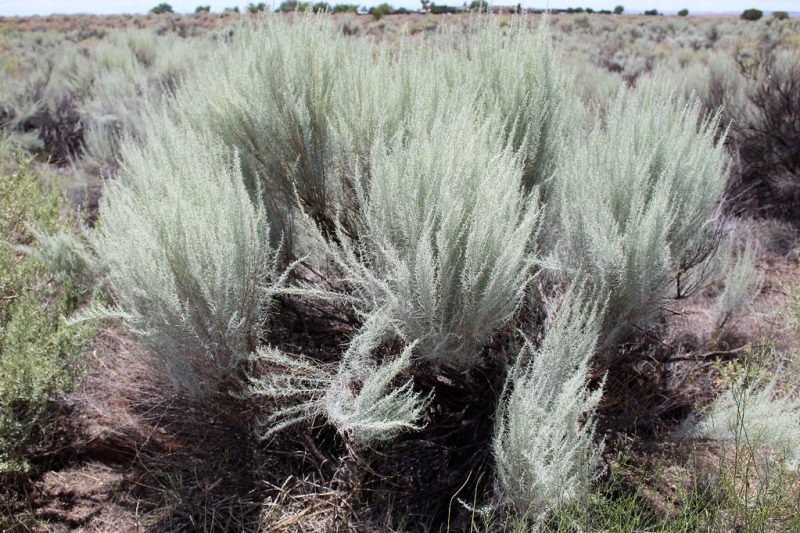
Artemisia filifolia, known as Sand Sagebrush, is a native shrub that grows in sandy soil environments across Arizona. This shrub generally reaches heights of 3-5 feet and is characterized by its fine, aromatic foliage and small yellow flowers.
Sand Sagebrush thrives in well-drained soils and requires minimal care once established, making it an ideal plant for xeriscape gardens. Its drought-resistant nature and ability to withstand tough conditions make it an essential element in stabilizing fragile desert ecosystems. Regular pruning can help maintain shape and vitality. For gardeners seeking an authentic native appearance, Sand Sagebrush stands as an attractive, low-maintenance option.
Sophora secundiflora (Texas Mountain Laurel)
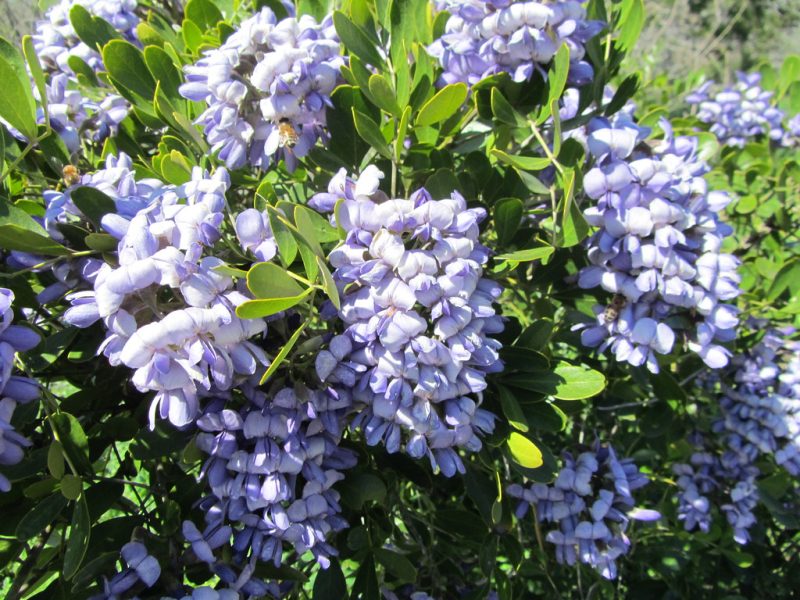
Sophora secundiflora, or Texas Mountain Laurel, is an evergreen shrub that’s prized for its exotic, fragrant purple blooms and dark green foliage. Growing to heights of 10-15 feet, this shrub can add year-round appeal and is often used as a privacy screen.
Texas Mountain Laurel thrives in well-drained soils and full sunlight, with moderate irrigation needs. Once established, it becomes drought-tolerant and creates a stunning seasonal display with brightly colored flowers. Minimal pruning is needed, although reshaping helps create a visually appealing structure. With its resistance to heat and drought, this plant remains a favorite among gardeners looking to enhance their landscapes.
Olneya tesota (Desert Ironwood)
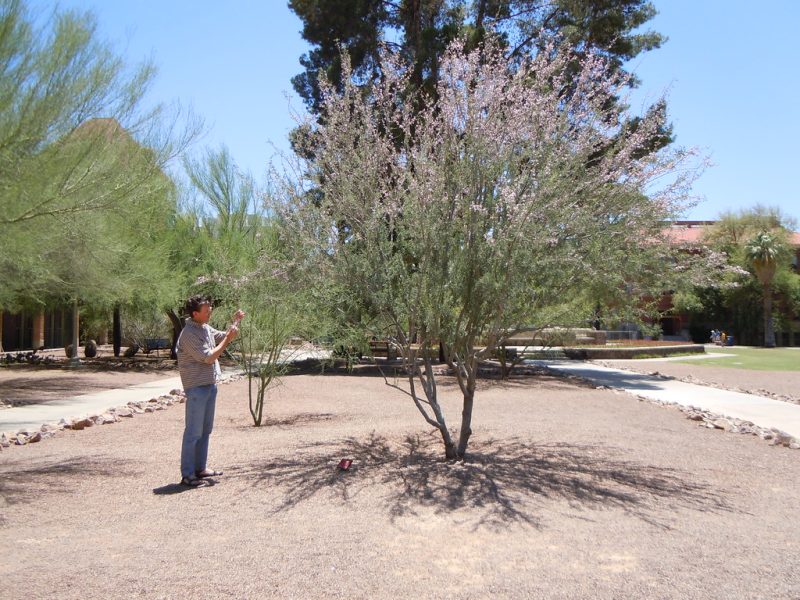
Olneya tesota, or Desert Ironwood, is a magnificent shrub or small tree known for its sturdy trunk and beautiful purple flowers. This specimen can grow up to 30 feet tall and features aromatic foliage, making it a striking addition to any landscape.
Desert Ironwood thrives in dry, well-drained soils and requires very little water once established. Its dense structure makes it excellent for providing shade, and the stunning blooms and subsequent pods attract a variety of wildlife. Regular pruning helps maintain its size and enhances its bushiness, ensuring it remains a refined element in gardens while showcasing its remarkable resilience.
Simmondsia chinensis (Jojoba)
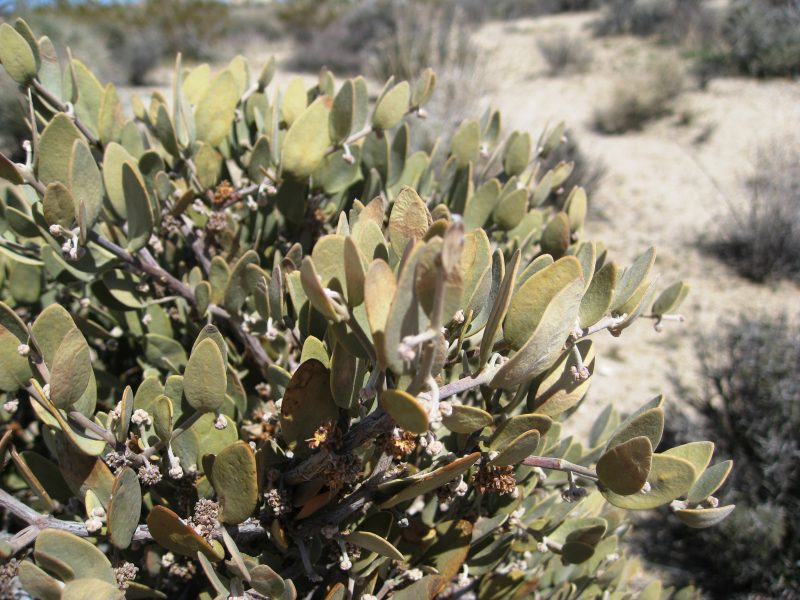
Simmondsia chinensis, or Jojoba, is a unique flowering shrub known for its glossy leaves and exquisite yellow flowers. This plant grows 2-10 feet high and produces small, edible seeds commonly known for their oil, offering beauty and practical use in any garden.
Jojoba thrives in well-drained sandy soils and full sun, making it a fantastic addition to xeriscape designs. The plant has minimal water requirements once established and is pest-resistant, contributing to its low-maintenance appeal. Regular pruning can enhance its growth and bushiness, leading to a more attractive shrub presence. Jojoba is a worthy choice for gardeners looking to combine functional beauty with resilience in arid environments.


